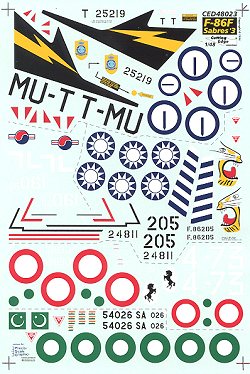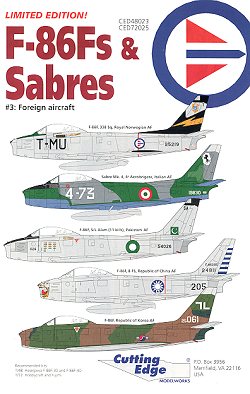|
Sheet # |
Cutting Edge 48-023 for 1/48 F-86F |
|
Price: |
$7.98 |
|
Units: |
See
review |
|
Review By: |
Scott Van Aken |
|
Notes: |
|
 I mentioned the
Hunter as being one of the quintessential fighter jet designs of all time.
Another is the F-86 Sabre. It is probably one of the purest forms of jet
aircraft ever developed. Basically it just looks right. It was not burdened by
massive avionics systems or external missiles. No fly by wire or defensive ECM
equipment; just what is needed to fly and fight. Like most post WW2 jets, it's
design was not much more complicated than that of its earlier piston-powered
predecessors.
I mentioned the
Hunter as being one of the quintessential fighter jet designs of all time.
Another is the F-86 Sabre. It is probably one of the purest forms of jet
aircraft ever developed. Basically it just looks right. It was not burdened by
massive avionics systems or external missiles. No fly by wire or defensive ECM
equipment; just what is needed to fly and fight. Like most post WW2 jets, it's
design was not much more complicated than that of its earlier piston-powered
predecessors.
There have been two excellent 1/48 F-86 kits released in recent
years. One by Academy and the other by Hasegawa. Those wishing to purchase this
sheet need to know that it is designed for the Hasegawa kit. While undoubtedly
it will fit the Academy kit, the choice of subjects limits its use.
Basically, the Hasegawa kit is an F-40 variant of the F-86,
while the Academy version is the F-30. In a nutshell, it comes down to wings.
The F-40 does away with the small wing fence of the -30 and it has extended wing
tips that the F-30 does not have. As they are in the box, only the Italian and
maybe the Taiwanese schemes can be used with the Academy kit. The others all
require the extended wings provided by Hasegawa.
On to the markings on the sheet:
First is a Norwegian AF -35. It is from 338 Sq and has the
extened wings of the -40. It also has a different seat, the Martin Baker R5, so
some modifications will be needed in that area to do an accurate Norwegian
aircraft. It is depicted as it was in 1965.
Next is a Canadair Sabre 4 of the Italian AF. It can be built
using the Academy kit as the Sabre 4 was basically a -30 airframe. This one is
from 4 Aerobigata in 1957.
Next is a Pakistani AF -40. This aircraft depicts the mount of
Squadron Leader Modhammed Mahmood Alam, an ace of the 1965 Indo-Pakistani war,
and includes his kill markings.
The -30 below that is from the Nationalist Chinese AF around
1957. There is no verbal indication of what wing this one carried although the
insignia placement diagram shows the extended -40 wings. A number of -30 and -35
airframes were coverted to the -40 wings so proper photographic evidence is
needed when doing one of these aircraft. The Taiwanese were the first to
successfully use the Sidewinder, so it would be proper to equip this as well as
the Pakistani aircraft with missile rails.
Finally is a -30 (with the -40 wings) of the South Korean AF,
circa 1974. This aircraft is resplendent in the SEA scheme of tan, two greens
and a lower light grey.
Five really great schemes. As with most decal sheets, the
biggest problem is deciding which one to use.
Review copy courtesy of me
and my wallet!! If any of you manufacturers or shop owners want to send products
for review and building, please contact
me.
 I mentioned the
Hunter as being one of the quintessential fighter jet designs of all time.
Another is the F-86 Sabre. It is probably one of the purest forms of jet
aircraft ever developed. Basically it just looks right. It was not burdened by
massive avionics systems or external missiles. No fly by wire or defensive ECM
equipment; just what is needed to fly and fight. Like most post WW2 jets, it's
design was not much more complicated than that of its earlier piston-powered
predecessors.
I mentioned the
Hunter as being one of the quintessential fighter jet designs of all time.
Another is the F-86 Sabre. It is probably one of the purest forms of jet
aircraft ever developed. Basically it just looks right. It was not burdened by
massive avionics systems or external missiles. No fly by wire or defensive ECM
equipment; just what is needed to fly and fight. Like most post WW2 jets, it's
design was not much more complicated than that of its earlier piston-powered
predecessors.